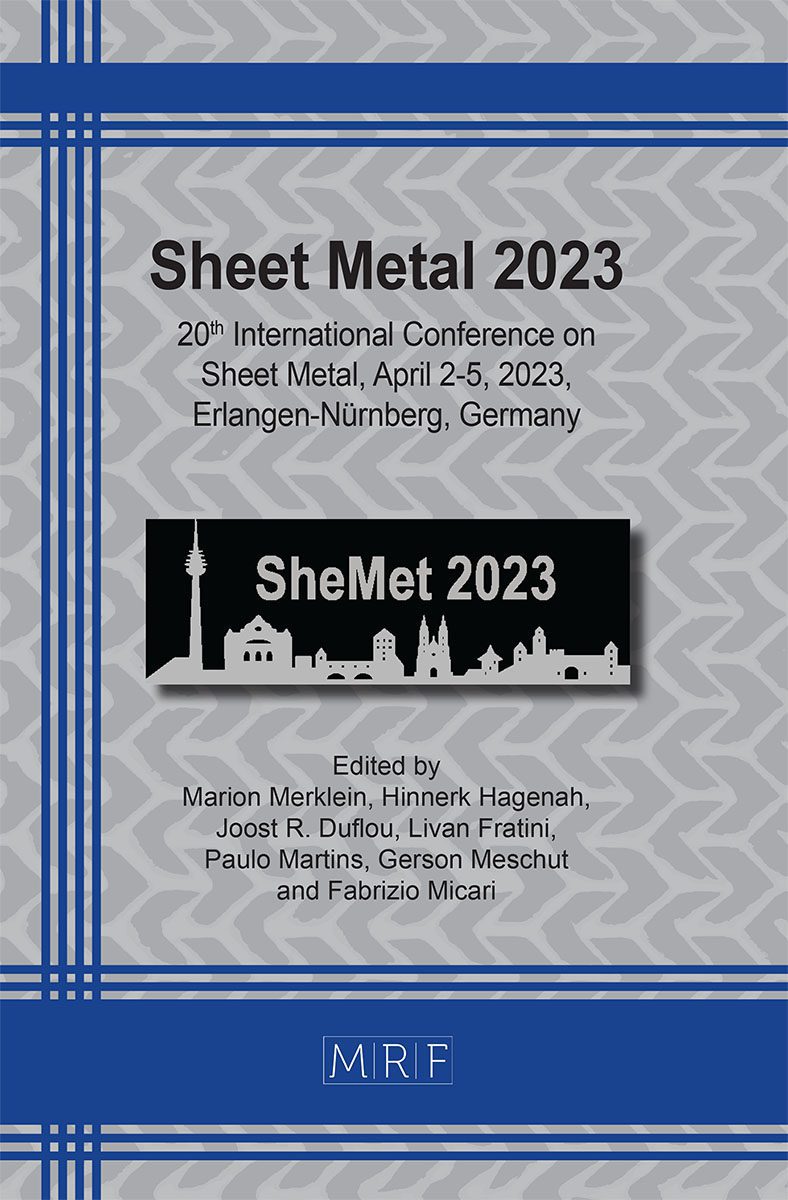Friction behavior under magnetorheological lubricant in sheet metal forming process
Michele Brun, Enrico Simonetto, Andrea Ghiotti, Stefania Bruschi
download PDFAbstract. The increasingly high standards required in sheet metal forming industry, both geometrical and aesthetical, lead to continuous search of solutions to control the metal sheet flow during deformation. As alternative to traditional draw beads or hydraulically controlled segmented dies, the possibility of locally varying the material tangential speed by adapting the surface tribology at the interface between the blank and the blank holder represents a still unexplored scenario. The paper presents the feasibility analysis of the use of magneto-rheological (MR) fluids as lubricants in stamping, exploiting their ability to vary their rheological behaviour in response to external magnetic fields. To this aim, a new strip drawing test bench was developed to investigate the friction behaviour of MR fluids under different magnetic fields. The cold stamping of DC05 steel sheet was taken as reference case to investigate the influence of typical process parameters such as contact pressure, sliding speed and magnetic field.
Keywords
Friction, Lubrication, Magneto-Rheological Fluid
Published online 3/17/2023, 8 pages
Copyright © 2023 by the author(s)
Published under license by Materials Research Forum LLC., Millersville PA, USA
Citation: Michele Brun, Enrico Simonetto, Andrea Ghiotti, Stefania Bruschi, Friction behavior under magnetorheological lubricant in sheet metal forming process, Materials Research Proceedings, Vol. 25, pp 281-288, 2023
DOI: https://doi.org/10.21741/9781644902417-35
The article was published as article 35 of the book Sheet Metal 2023
![]() Content from this work may be used under the terms of the Creative Commons Attribution 3.0 licence. Any further distribution of this work must maintain attribution to the author(s) and the title of the work, journal citation and DOI.
Content from this work may be used under the terms of the Creative Commons Attribution 3.0 licence. Any further distribution of this work must maintain attribution to the author(s) and the title of the work, journal citation and DOI.
References
[1] Mark R Jolly, Jonathan W. Bender and J. David Carlson, Properties and Applications of commercial Magnetorheological fluids, Journal of Intelligent Material Systems and Structures 10: 5 (1999). https://doi.org/10.1177/1045389X9901000102
[2] A. G. Olabi, A. Grunwald, Design and application of magneto-rheological fluid, Materials and Design, 28(2007) 2658-2664. https://doi.org/10.1016/j.matdes.2006.10.009
[3] G. Yang, B. F. Spencer Jr. J. D. Carlson, M. K. Sain, Large-scale MR fluid dampers: modelling and dynamic performance considerations, Engineering Structures 24 (2002) 309-323. https://doi.org/10.1016/S0141-0296(01)00097-9
[4] Jorge de Jesus Lozoya-Santos, Olivier Sename, Luc Dugard, Ruben Morales-Menendez, Ricardo Ramirez-Mendoza, A Semi-active Control-oriented Damper Model for an Automotive Suspension, IFAC Proceedings Volumes, 43: 7 (2010) 336-341. https://doi.org/10.3182/20100712-3-DE-2013.00158
[5] R. N. Yerrawar, R. R. Arakerimath, Development of Methodology for Semi Active Suspension System Using MR Damper, Materials Today: Proceedings 4 (2017) 9294-9303. https://doi.org/10.1016/j.matpr.2017.07.289
[6] Edward J. Park, Luis Falcao da Luz, Afzal Suleman, Multidisciplinary design optimization of an automotive magnetorheological brake design, computers and Structures 86 (2008) 207-216. https://doi.org/10.1016/j.compstruc.2007.01.035
[7] K. Hema Latha, P. Usha Sri, N. Seetharamaiah, Design and Manufacturing Aspects of Magneto-rheological Fluid (MRF) Clutch, Materials Today: Proceedings 4 (2017) 1525-1534. https://doi.org/10.1016/j.matpr.2017.01.175
[8] Antonio Lanzotti, Fabrizio Renno, Michele Russo, Riccardo Russo, Mario Terzo, Design and development of an automotive magnetorheological semi-active differential, Mechatronics 24 (2014) 426-435. https://doi.org/10.1016/j.mechatronics.2014.04.002
[9] A. Ghiotti, P. Regazzo, S. Bruschi, P.F. Bariani, Reduction of vibrations in blanking by MR dampers, CIRP Annals – Manufacturing Technology 59 (2010) 275-278. https://doi.org/10.1016/j.cirp.2010.03.111
[10] Andrea Ghiotti, Stefania Bruschi, Paolo Regazzo, Shear surface control in blanking by adaptronic systems, Procedia Engineering 81 (2014) 2512-2517. https://doi.org/10.1016/j.proeng.2014.10.359
[11] Rahul Kishore, Sounak K. Choudhury, Kashfull Orra. On-line control of machine tool vibration in turning operation using electro-magneto rheological damper, Journal of Manufacturing Processes 31 (2018) 187-198. https://doi.org/10.1016/j.jmapro.2017.11.015
[12] E. Diaz-Tena, L. N. Lopez de Lacalle Marcaide, F.J. Campa Gomez, D.L. Chaires Bocanegra, Use of Magnetorheological Fluids for Vibration Reduction on the Milling of Thin Floor Parts, Procedia Engineering 63 (2013) 835-842. https://doi.org/10.1016/j.proeng.2013.08.252
[13] Young-Won Yun, Jyung Sub Bae, Myeong-Kwan Park, A Study of the control of blank holding force using an MR damper in a drawing press, Journal of mechanical science and Technology, 24: 11 (2020) 2281-2288. https://doi.org/10.1007/s12206-010-0808-3
[14] Benny Endelt, Søren Tommerup, Joachim Danckert, A novel feedback control system – Controlling the material flow in deep drawing using distributed blank-holder force, Journal of Material Processing Technology 213 (2013) 36-50. https://doi.org/10.1016/j.jmatprotec.2012.08.003
[15] Martin Barthau, Mathias Liewald, New approach on controlling strain distribution manufactured in sheet metal components during deep drawing process, Procedia Engineering 207 (2017) 66-71. https://doi.org/10.1016/j.proeng.2017.10.740































